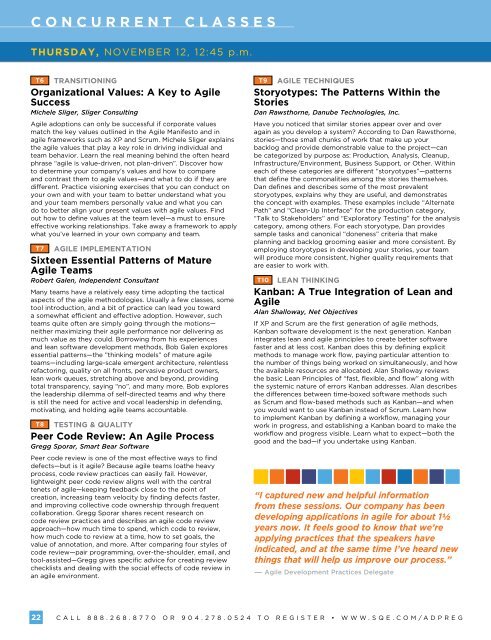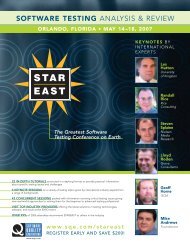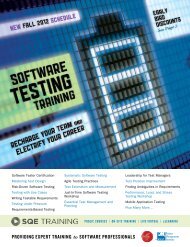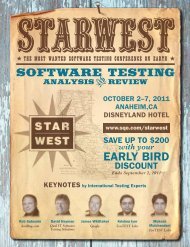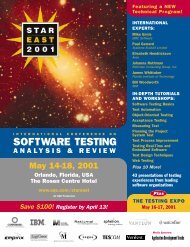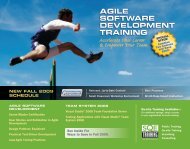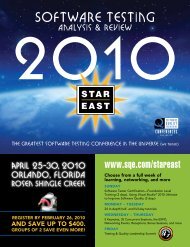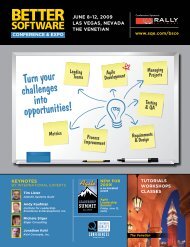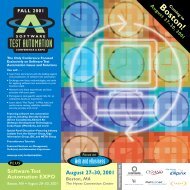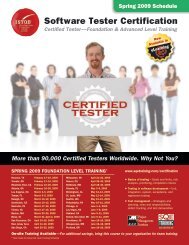concurrent classesthursDAY, november 12, 12:45 p.m.T6 TransitioningOrganizational Values: A Key to <strong>Agile</strong>SuccessMichele Sliger, Sliger Consulting<strong>Agile</strong> adoptions can only be successful if corporate valuesmatch the key values outlined in the <strong>Agile</strong> Manifesto and inagile frameworks such as XP and Scrum. Michele Sliger explainsthe agile values that play a key role in driving individual andteam behavior. Learn the real meaning behind the often heardphrase “agile is value-driven, not plan-driven”. Discover howto determine your <strong>com</strong>pany’s values and how to <strong>com</strong>pareand contrast them to agile values—and what to do if they aredifferent. Practice visioning exercises that you can conduct onyour own and with your team to better understand what youand your team members personally value and what you cando to better align your present values with agile values. Findout how to define values at the team level—a must to ensureeffective working relationships. Take away a framework to applywhat you’ve learned in your own <strong>com</strong>pany and team.T7 <strong>Agile</strong> ImplementationSixteen Essential Patterns of Mature<strong>Agile</strong> TeamsRobert Galen, Independent ConsultantMany teams have a relatively easy time adopting the tacticalaspects of the agile methodologies. Usually a few classes, sometool introduction, and a bit of practice can lead you towarda somewhat efficient and effective adoption. However, suchteams quite often are simply going through the motions—neither maximizing their agile performance nor delivering asmuch value as they could. Borrowing from his experiencesand lean software development methods, Bob Galen exploresessential patterns—the ”thinking models” of mature agileteams—including large-scale emergent architecture, relentlessrefactoring, quality on all fronts, pervasive product owners,lean work queues, stretching above and beyond, providingtotal transparency, saying “no”, and many more. Bob exploresthe leadership dilemma of self-directed teams and why thereis still the need for active and vocal leadership in defending,motivating, and holding agile teams accountable.T8 Testing & QualityPeer Code Review: An <strong>Agile</strong> ProcessGregg Sporar, Smart Bear SoftwarePeer code review is one of the most effective ways to finddefects—but is it agile? Because agile teams loathe heavyprocess, code review practices can easily fail. However,lightweight peer code review aligns well with the centraltenets of agile—keeping feedback close to the point ofcreation, increasing team velocity by finding defects faster,and improving collective code ownership through frequentcollaboration. Gregg Sporar shares recent research oncode review practices and describes an agile code reviewapproach—how much time to spend, which code to review,how much code to review at a time, how to set goals, thevalue of annotation, and more. After <strong>com</strong>paring four styles ofcode review—pair programming, over-the-shoulder, email, andtool-assisted—Gregg gives specific advice for creating reviewchecklists and dealing with the social effects of code review inan agile environment.T9 <strong>Agile</strong> TechniquesStoryotypes: The Patterns Within theStoriesDan Rawsthorne, Danube Technologies, Inc.Have you noticed that similar stories appear over and overagain as you develop a system? According to Dan Rawsthorne,stories—those small chunks of work that make up yourbacklog and provide demonstrable value to the project—canbe categorized by purpose as: Production, Analysis, Cleanup,Infrastructure/Environment, Business Support, or Other. Withineach of these categories are different “storyotypes”—patternsthat define the <strong>com</strong>monalities among the stories themselves.Dan defines and describes some of the most prevalentstoryotypes, explains why they are useful, and demonstratesthe concept with examples. These examples include “AlternatePath” and “Clean-Up Interface” for the production category,“Talk to Stakeholders” and “Exploratory Testing” for the analysiscategory, among others. For each storyotype, Dan providessample tasks and canonical “doneness” criteria that makeplanning and backlog grooming easier and more consistent. Byemploying storyotypes in developing your stories, your teamwill produce more consistent, higher quality requirements thatare easier to work with.T10 Lean ThinkingKanban: A True Integration of Lean and<strong>Agile</strong>Alan Shalloway, Net ObjectivesIf XP and Scrum are the first generation of agile methods,Kanban software development is the next generation. Kanbanintegrates lean and agile principles to create better softwarefaster and at less cost. Kanban does this by defining explicitmethods to manage work flow, paying particular attention tothe number of things being worked on simultaneously, and howthe available resources are allocated. Alan Shalloway reviewsthe basic Lean Principles of “fast, flexible, and flow” along withthe systemic nature of errors Kanban addresses. Alan describesthe differences between time-boxed software methods suchas Scrum and flow-based methods such as Kanban—and whenyou would want to use Kanban instead of Scrum. Learn howto implement Kanban by defining a workflow, managing yourwork in progress, and establishing a Kanban board to make theworkflow and progress visible. Learn what to expect—both thegood and the bad—if you undertake using Kanban.“I captured new and helpful informationfrom these sessions. Our <strong>com</strong>pany has beendeveloping applications in agile for about 1½years now. It feels good to know that we’reapplying practices that the speakers haveindicated, and at the same time I’ve heard newthings that will help us improve our process.”— <strong>Agile</strong> <strong>Development</strong> <strong>Practices</strong> Delegate22Call 888.268.8770 or 904.278.0524 to register • WWW.<strong>SQE</strong>.COM/ADPREG
concurrent classesMONDAY, may 16, 8:30-5:00thursDAY, november 12, 2:45 p.m.T11 TransitioningThe <strong>Agile</strong> PMP: Teaching an Old DogNew TricksMike Cottmeyer, VersionOne<strong>Agile</strong> methods emphasize trust, empowerment, andcollaboration—moving us away from <strong>com</strong>mand and controlproject management to harness the passion, creativity,and enthusiasm of the team. In established organizations,success with agile practices hinges on how well traditionalproject managers adopt new ways of thinking about projectstructure and control. Building on the principles of the ProjectManagement Body of Knowledge (PMBOK ® ), Mike Cottmeyerexplores how PMPs experienced in traditional developmentcan adapt their styles and practices to be<strong>com</strong>e effective agileproject leaders. Mike tackles the hidden assumptions behindthe PMBOK ® and explores agile approaches for managing time,cost, and scope. Taking an in-depth look at PMI processes andknowledge areas, he also explores ways you can adapt themto agile projects. Project managers, business analysts, and allstakeholders will leave with a new way of thinking about projectmanagement practices within the agile context and new toolsfor delivering value in the face of uncertainty.PMP ® and PMBOK ® are registered trademarks of the Project Management Institute.T12 <strong>Agile</strong> ImplementationIteration Management: Unclogging Your<strong>Development</strong> ProcessTiffany Lentz, ThoughtWorks, and Petra Skapa, The Gap, Inc.Within the agile development lifecycle, the role of “iterationmanager” is crucial for maintaining the rhythm and flow ofthe project. From leading the stand-ups, reviewing plans andestimates, <strong>com</strong>municating the status of the iteration to thecustomer, and escalating roadblocks to executive management,the iteration manager focuses on and supports the team’sdaily efforts. Tiffany Lentz and Petra Skapa describe the roleof iteration manager and <strong>com</strong>pare it to other roles, includingScrumMaster, technical manager, project manager, and productmanager. Tiffany and Petra describe the key activities and skillsrequired to be an effective iteration manager from the beginningof the iteration to its end, including the characteristics of a goodIM, the best methods for acquiring necessary skills, how to applythem, and the risks your project incurs if no one takes on this role.In that situation, <strong>com</strong>munication and visibility suffer, customertrust in the team erodes, and morale declines. The IterationManager ToolKit, provided on CD to participants, gives agileteams a jumpstart on taking their development to the next level.T13 Testing & QualityCritical Incidents While Testing in ScrumRob Sabourin, AmiBug.<strong>com</strong>Scrum frameworks deliver working code in time-boxed sprints.Many <strong>com</strong>munities find Scrum to be a wonderful balancebetween discipline and agility because it tames turbulence andfocuses teams. However, Scrum requires dramatic rethinkingof the traditional role of testing in a development project. RobSabourin explores critical testing incidents in Scrum projects—key turning points, difficult decisions, major problems, brilliantsuccesses, and dismal failures. Rob identifies key skills, practices,and techniques used to confidently deliver working code eachsprint. Rob shows how testing is implemented by teams indifferent organizational, business, and technical contexts. Hisfindings raise important questions and identify some novelsolutions. Do we really need testers in Scrum? Learn howteams solve tough security, performance, reliability, scalability,usability, and regression testing challenges. Explore ways testersand developers collaborate, preserving tester independencewithin small cross functional teams.T14 <strong>Agile</strong> Techniques<strong>Agile</strong> Architecture: Patterns andTechnologyKirk Knoernschild, Burton GroupDespite our wishing it were so, software architecture isnot static throughout a project, especially within an agiledevelopment environment. <strong>Agile</strong> architecture is defined byour willingness and ability to embrace and ac<strong>com</strong>modatearchitectural changes that emerge during the project.<strong>Agile</strong> architecture issues are both temporal—when to makearchitectural decisions—and structural, demanding thatthe architect and architecture remain flexible and able toac<strong>com</strong>modate change. Kirk Knoernschild examines thesetwo aspects of agile architecture, exploring the concepts ofarchitecture throughout the agile lifecycle and describing theactivities agile architects perform. Join with Kirk to discussarchitecture modularity issues, and how to deconstruct largesystems to increase flexibility, reusability, maintainability,extensibility, and testability. Explore the inextricable linksbetween temporal and structural agile architecture as youexamine the patterns and technologies that lead to a truly agilearchitecture.T15 Lean ThinkingEmbracing Kanban: An ExperienceReportChris Shinkle, Software Engineering ProfessionalsEarly in 2004, Chris Shinkle’s <strong>com</strong>pany began adopting agilepractices. Unfortunately, agile did not have the desired culturalimpact within their organization—and the adoption floundered.Several years later, Chris found himself coaching a fellowproject lead several months into a difficult project. The projectteam had experienced developers but faced a seeminglyimpossible deadline. Discontent and frustration were rampantand something needed to change. Chris decided that a Kanbanimplementation could improve the situation. The team quicklydiscovered the primary reason for their long lead times—a hugeWork In Progress (WIP) count. As the team sought to reduce itsWIP using Lean principles, they eliminated considerable wastein their processes, reduced bottlenecks, and made significantprocess improvements. In a short six months, they moved fromchaos to a state of continuous improvement. Chris shares theirlessons learned and explains how the team grew during theproject. Learn the effect of expedited work items, the real costof rework, and how to make quality a focus throughout yoursoftware process.“I liked the ability to hearother views on agility—to[get a] better perspectiveof what others are doing.”— William Ploch, Project Leader, EnergizerCall 888.268.8770 or 904.278.0524 to register • WWW.<strong>SQE</strong>.COM/ADPREG23
- Page 2: Agile DevelopmentPractices Conferen
- Page 5 and 6: wednesday, november 118:309:4510:00
- Page 7 and 8: conference speakersKeynoteSpeakerTu
- Page 9 and 10: pre-conference tutorialsMONDAY, nov
- Page 11 and 12: pre-conference tutorialsTUESDAY, no
- Page 13 and 14: pre-conference tutorialsTUESDAY, no
- Page 15 and 16: Agile Testing Workshop Sessionsmond
- Page 17 and 18: keynote sessionsMONDAY, may 16, 8:3
- Page 19 and 20: concurrent classesMONDAY, may 16, 8
- Page 21: concurrent classesMONDAY, may 16, 8
- Page 25 and 26: Agile Leadership Summit Sessionsfri
- Page 27 and 28: sponsors and exhibitorsconference s
- Page 29 and 30: Lean-Agile ScrumMaster TrainingNew
- Page 31 and 32: agile development practices Registr


